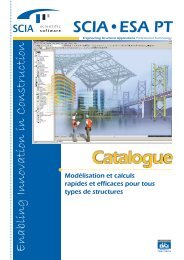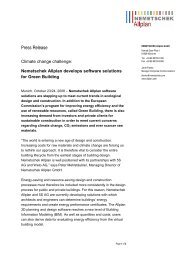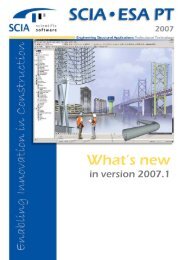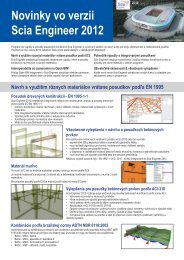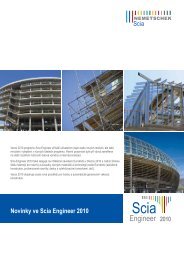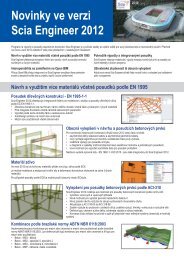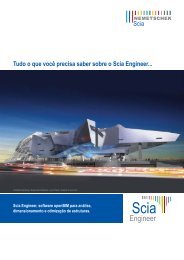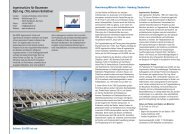VSH Turòa nad Bodvou - Nemetschek Scia
VSH Turòa nad Bodvou - Nemetschek Scia
VSH Turòa nad Bodvou - Nemetschek Scia
Create successful ePaper yourself
Turn your PDF publications into a flip-book with our unique Google optimized e-Paper software.
Administration building realized by IPES n.v.<br />
Client: Liberty Invest n.v.<br />
Architects: Ivan Van Mossevelde; D & C Van Impe<br />
Technical data<br />
Dimensions: ± 108m x 55m<br />
Surface: 15,000 m²<br />
Storeys: 6 + 2 (underground parking)<br />
Roofing system: built-up roof<br />
Wall system: steel / glass façade<br />
Project description<br />
This impressive 6-storey steel building, achieved in August 2005, is<br />
situated on the city limits of Ghent, one of Europe’s most famous<br />
port cities.<br />
IPES’ new headquarters were conceived to reflect an image of a<br />
contemporary port, symbolising the history and trades that made<br />
Ghent famous.<br />
Flexible solutions, solid structural design combined with esthetics,<br />
competitive pricing: ASTRON has adapted its systems well to the<br />
new market requirements and has in the past collected the necessary<br />
know-how to successfully manage all large scale projects.<br />
For the Floralis project, the main advantages were the price and<br />
the reliable short delivery terms, as well as the simple erection<br />
with steel beams incorporated in the intermediate floors. This<br />
latter feature provided excellent free heights between the floors as<br />
well as reducing the structural area that had to be painted for fire<br />
protection. Installation of services proved to be much easier as with<br />
traditional solutions.<br />
Floors are set back from one another which, combined with the<br />
intensive use of glass and aluminum, plus the rotunda with its<br />
granite cladding, serve to give the Floralis building a modern and<br />
contemporary look.<br />
Completed only 15 months after work started, it will accommodate<br />
such renowned companies as Esko graphics, BMT and the administration<br />
centre of the Ghent-based Floralies.<br />
Two levels of underground parking were incorporated into the<br />
design.<br />
Description how software was used<br />
Input<br />
After job clarification, our customer needs very quickly (a matter of<br />
days) the anchor bolt reactions and lay-out. Therefore we need a<br />
tool with a quick and easy input.<br />
Among other advantages, the input of the structure and the loads<br />
is quite easy and time saving due to the fact that even wind loads<br />
don’t need to be calculated separately for each column and beam,<br />
but can be generated automatically.<br />
Once the model is defined and completely introduced, the input<br />
data can be very easily checked and a quick structural analysis<br />
according first order theory is executed. Due to the multitude of<br />
countries to which we are selling buildings, it is very important not<br />
only to have one standard (Eurocode) but a multitude of codes. For<br />
countries not included in ESA-Prima Win standards, the adaptation<br />
of safety factors and load combination factors makes it possible to<br />
work with only one single design tool.<br />
The model<br />
The entire steel structure is modelled as a 3D model in ESA-<br />
Prima Win. The static design and the verification of the standard<br />
hot rolled sections for columns, roof beams and floor beams are<br />
detailed and processed in the model. The concrete staircases and<br />
the concrete walls of the ground-floor are simulated as supports,<br />
generating foundation reactions.<br />
3Dimensional rendering<br />
This tool is used to get a realistic representation of the structure<br />
allowing new customers of a quicker comprehension of the structure<br />
and helps him to see his project during the different phases<br />
and under different angles.<br />
Diaphragm simulation of the floors<br />
The floor of our standard building consists of concrete hollow core<br />
elements which are simulated by diagonals in the floor beam area.<br />
This allows a precise generation and definition of the loads in the<br />
concrete staircases, steel stabilization crosses and steel frames.<br />
Verification according 2nd order<br />
After the model and the loads have been completely introduced,<br />
we check the second order behaviour of the structure. This allows<br />
also a precise analysis of the horizontal and vertical deformations.<br />
Dynamic seismic analysis<br />
For projects located in areas with seismic solicitation, the model is<br />
submitted to nodal analysis by ESA-Prima Win.<br />
Steel code check<br />
The main part of the different steel elements was checked and optimized<br />
with ESA-Prima Win. This allows to order material in a very<br />
early stage of the project and to reduce delivery time. In addition, a<br />
precise weight, cost and project follow up is given.<br />
Only the floor integrated beams (INODEK) consisting of a hot<br />
rolled T-cut section with a welded wider lower flange are designed<br />
separately.<br />
Administration building Floralis<br />
121




